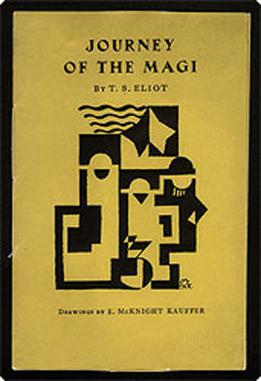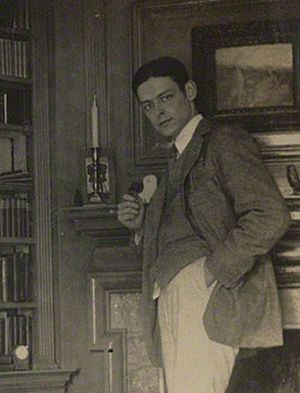Journey of the Magi facts for kids
| by T. S. Eliot | |

The cover of the poem's first publication, Faber & Gwyer's 1927 pamphlet
|
|
| Written | 1927 |
|---|---|
| First published in | Ariel poems |
| Illustrator | Edward McKnight Kauffer |
| Form | Dramatic monologue |
| Meter | Free verse |
| Publisher | Faber and Gwyer |
| Publication date | August 1927 |
| Lines | 43 |
"Journey of the Magi" is a 43-line poem written in 1927 by T. S. Eliot (1888–1965). It tells the story of the biblical Magi, also known as the Three Wise Men. They traveled to visit the newborn Jesus, as described in the Gospel of Matthew.
The poem is told from the point of view of one of the Magi. It explores feelings of change and being out of place in a world that feels different. This poem was part of a special collection called the Ariel Poems. These were released as small books by a British publisher called Faber and Gwyer.
Contents
About the Poem
"Journey of the Magi" was the eighth poem in the "Ariel Poems" series. It was published in August 1927. The poem included pictures by an American artist named Edward McKnight Kauffer (1890–1954).
Eliot wrote this poem after he became a member of the Church of England. This change in his beliefs started to show in his poetry. His later poems, including the "Ariel Poems," often had religious themes.
The poem is a dramatic monologue. This means it's like a speech given by one character. It also uses quotes and ideas from older writers like Lancelot Andrewes and Matthew Arnold.
How the Poem Was Written and Published
In 1925, T. S. Eliot started working as a poetry editor. He joined the publishing company Faber and Gwyer in London. Before this, he had worked in banking. He was already a well-known poet. Some of his famous earlier poems include "The Love Song of J. Alfred Prufrock" (1915) and "The Waste Land" (1922).
Around this time, Eliot became more interested in the Church of England. He was baptized into the Anglican faith in June 1927. He later said he saw himself as a classicist in literature and an Anglo-Catholic in religion. This change in his beliefs had a big impact on his later poems.
Some critics thought Eliot's poems became less strong with Christian themes. Others believed it was a good change. They saw it as a way for Eliot to explore ideas about old age and the soul's journey.
The Ariel Poems Series
In 1927, Eliot's boss, Geoffrey Faber, asked him to write a poem each year. These poems were for a series of illustrated pamphlets. They were meant to be Christmas greetings for the company's clients. This series was called the "Ariel Series." It included 38 pamphlets by different English writers and poets.
"Journey of the Magi" was the first poem Eliot wrote for this series. It came out as the eighth pamphlet in August 1927. Eliot wrote four more poems for the series. These included "A Song for Simeon" (1928) and "Marina" (1930). Four of Eliot's five "Ariel" poems, including "Journey of the Magi," had pictures by E. McKnight Kauffer.
The company printed "Journey of the Magi" as a small pamphlet. It had a yellow cover and pictures by Kauffer. About 5,000 copies were printed. There was also a special limited edition of 350 copies.
Later Collections
In 1936, Faber & Faber, the company that followed Faber & Gwyer, collected "Journey of the Magi" and three other "Ariel Poems." They put them in an edition of Eliot's collected poems.
Later, in 1954, Eliot added a sixth poem, "The Cultivation of Christmas Trees," to the series. This poem was included in Faber's 1963 edition of his collected poems. Both collected poem editions were also published in the United States.
All six "Ariel Poems" were published together as a separate book for the first time in 2014. This book included the original illustrations.
Images for kids




